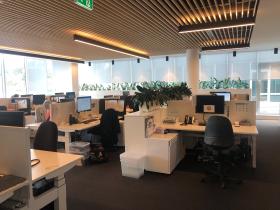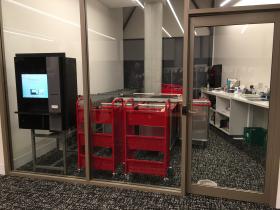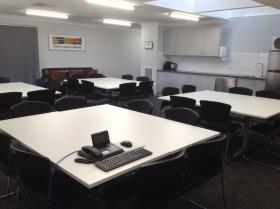Service area: Staff and non-public areas
Staff areas must be included in the planning stage for a new or refurbished library building.
Staff areas are frequently overlooked in library design or are the result of the leftover space once the public areas are planned. Their proximity to public areas as well as to service areas, entry and loading should be a critical element in the initial space planning of a library. Workflows need to be considered. How the staff areas relate to other areas of the library should directly reflect the library’s preferred work method.
Small libraries
For example, in small libraries, particularly when there may only be one or two staff on roster, the need for the staff to supervise public areas and serve customers will result in a staff area which is often open or transparent to public areas. Tasks which are commonly performed in the back of house may be undertaken in full view of the public and should preferably have facilities to lock up and leave as required.
Larger libraries
Larger libraries may employ staff where the majority of their work is undertaken in a non-public space and may therefore separate their staff areas to a much greater degree. The internal planning of the staff area must also integrally relate to work processes to encourage efficient work methods and adequate space to undertake tasks.
Functions allocated to staff areas
With a growing trend towards part time and casual workers, the flexibility of work areas should not be overlooked.
The functions considered to be allocated to staff areas include:

- collection management tasks (although many libraries are outsourcing much of collection processing)
- service and program development
- administration.
Other areas include:
- storage: general collection, special collection, large items
- space for volunteers to work
- staff amenities, kitchen/lunchroom, showers, lockers
- equipment hub: copiers, scanners, printers
- additional IT area and IT department.
Staff area design
The following need to be considered:
Working spaces
- number of staff and part time staff – permanent workstations, hot desks, flexible desk arrangements and enclosed offices
- hybrid work policies with staff working remotely and in the office. This includes a requirement for video conferencing facilities to connect remote and onsite staff, as well as staff with external stakeholders
- tasks to be undertaken including preparation, repair, scanning/copying.
- the location of work surfaces and storage/other equipment that is required nearby.
Access and storage
- space for server rooms, maintenance rooms and cleaning rooms
- proximity and ease of access to other staff facilities including locker rooms, showers, toilets and kitchen areas
- proximity to loading and home library services areas
- proximity to service desk and returns area
- storage requirement – proximity to work area, degree of environmental control
- a growing e-book collection and decreasing print collection would decrease space required for processing library material
- adequate trolley parking
- location of noticeboard
- location of CCTV station.
Collaboration spaces
- open and enclosed meeting areas which are central and welcoming
- potential to overlap meeting areas with public meeting rooms
- consider the trend towards social hubs which promote casual meeting and exchange
- technology to connect onsite staff with remote workers and external stakeholders.
Flexibility
- potential changes to service provision and processes e.g. increased outsourcing of collections procurement and management would decrease space required for these processes
- the impact of digital content and content creation and the consequent impact on work processes
- flexibility to rearrange spaces over time. As in the main library limit the intrusion of building structure and allow for flexible cabling/ lighting/air conditioning.
Environment and well-being
- supervision - overlooking of public areas
- adequate room for waste sorting
- natural daylight and outlook
- consider outdoor breakout spaces
- levels of acoustic and visual privacy
- privacy and security
- sick room – if space is adequate.
Floor plan and offices spaces
It is normal practice to provide open plan work areas for library staff, other than managers, which promote collaborative work practices and exchange. In these environments, the design of workstations and library partitions should accommodate both individual tasks and conversation. Partitions which are too high will reduce natural daylight and constrain the sense of space. Fully open plan offices, without partitions, are popular but the staff need to embrace a more active work environment and the space will normally require acoustic treatment to reduce noise intrusion.
A rule of thumb for areas:
- manager’s office: 12 to 20 m²
- team leaders and area managers: 10 to 14 m²
- shared office: 8 to 10 m²
- administrative staff: 8 to 12 m²
- open plan workstations: 8 m²
Return areas
While some libraries still undertake manual processing of returned books, the use of both RFID and automatic materials sorting are prevalent.
Whether book sorting systems are automated or not, a number of critical factors remain the same:
- the out-of-hours book return chute should be in a highly accessible, public location with good security and site supervision
- this chute will normally have a scanner (scanning member card or library material) to prevent unwanted items being dropped in
- fire rating and separation of this return from other areas should be considered
- while the books from this chute are sometimes conveyed to an alternate location either by trolley or by conveyor, it is optimal to locate the returns room in close proximity to the returns chute. This can frequently clash with the transparency and welcoming character of the entry and public areas. Careful planning is required to achieve both.
- internal planning of manual returns areas should consider space for bins - empty, full and in process
- consider if books can be conveyed to staff sorting area to reduce staff travel to and from the returns area
- the layout of the returns room should consider ergonomic principals, efficiency and ease of use including distance travelled, reach and height of work surfaces
- staff should be consulted in planning the returns room
- off-the-shelf equipment such as bins and chutes are available and the input of these suppliers can be useful in the planning of the returns area.
Automated solutions
There is an ever-increasing range of technology to assist in book sorting most of which is customised to the library space and library work practices. Automated book sorting has become the next step, after self-check, to free up staff time.
Other advantages include a greater capacity for out-of-hours book drops and shorter lead times for returned books. Some issues to consider include:

Oran Park Library ensure that the sorting system you choose is compatible or customisable to the LMS (Library Management System)
- to achieve the best solution for your library, the supplier should become involved in the early stages both to ensure that the equipment can fit and to take advantage of the customisable options available. For example, the book sorter might be designed to sort bins geographically.
- the integration of this equipment into the building can be complicated, particularly when books are transferred between floors or from one side of the library to the other, so it must be coordinated with the architecture, building services and structure
- a number of libraries have chosen to highlight the use of sorting machine technology by using glass walls or even allowing the conveyor to pass through public areas. Given the customisable nature of these machines, this technology should not overly impact on a better architectural solution.
Storage areas
Storage areas are essential within a public library with each activity and service likely to generate the demand for storage. Storage areas and specific types of storage equipment are often required for:
Children's and youth activities
- located within or nearby the children’s activity area
- consider large cupboards to store craft supplies, resources, toys and display boards
- a wet area with sink, water and storage is desirable
- door systems (sliding, bifold or hinged) to hide stored items and wet areas can create a higher quality environment for when these items are not in use
Multipurpose rooms

- typically need adjoining storeroom for chairs, tables, audiovisual equipment and meeting room equipment
- if the room is to be used regularly by community groups, individual lockable storage cupboards may be required for group equipment
Archives and conservation
- provision for compactus shelving may be necessary together with storage for specialist council collections, e.g. heritage items, art collections, artefacts etc.
Staff work areas
- storage cupboards
- bookshelves
- shelving in staff areas for stationery, resources, files and equipment
Larger back of house storage area
- typically libraries require storage for larger items which are used infrequently such as Christmas decorations and exhibition stands
Storage of users’ bags
- coin-operated lockers or open pigeonholes for library users to store excess bags
Cleaner’s room
- shelving and cupboards for cleaning materials and equipment